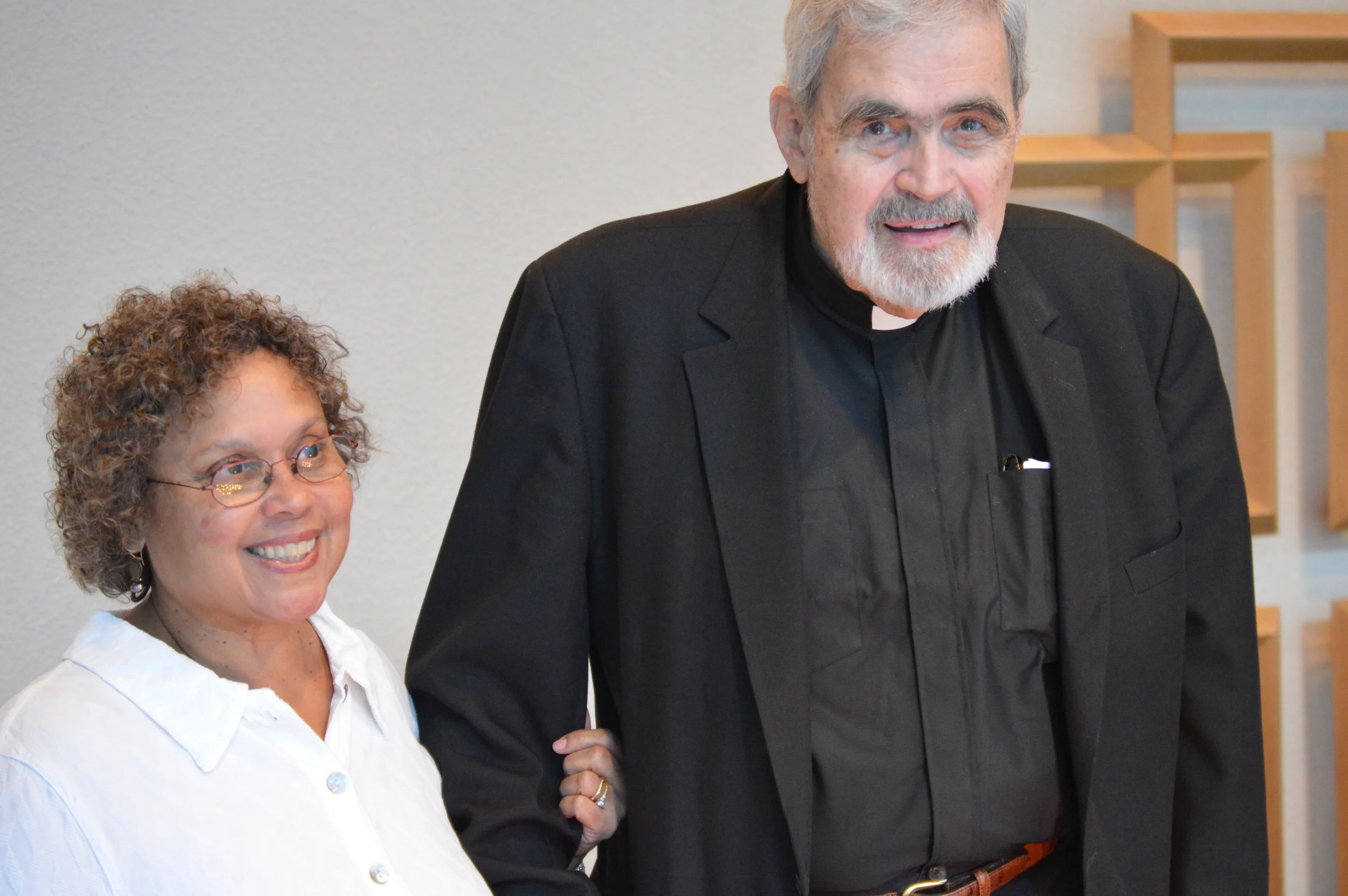Jazz Pastor Emeritus Dale R. Lind
Pastor Lind presiding in the Old Saint Peter’s (Courtesy Dale R. Lind)
Pastor Lind presiding behind the bar (Courtesy Dale R. Lind)
Outside Knicker’s Bar (Courtesy Dale R. Lind)
Pastor Lind during the 2006 season of Jazz on the Plaza (Saint Peter’s Archive)
Pastor Lind during the 2006 season of Jazz on the Plaza (Saint Peter’s Archive)
Pastor Lind at 2012 Clark Terry Benefit (Ed Berger)
Jazz Pastor Emeritus Dale R. Lind and Marsha Clark Lind in 2017
Pastor Lind celebrating his 60th Anniversary of Ordination in 2024
In Summer 2025, Pastor Jared R. Stahler, and Tyler Bassett, Manager for Programs and Communication, sat down to reflect on more than 60 years of history — jazz ministry, bar ministry, New York City and more — with Jazz Pastor Emeritus Dale R. Lind and Marsha Clark Lind. This is Part I of the interview, edited for clarity and brevity.
JRS: We are here with Jazz Pastor Emeritus Dale R. Lind and Marsha Clark Lind. No one knows the history of Jazz at Saint Peter’s better. Pastor Lind, you have been here since 1964, when you were Assistant Pastor for Young Adult Ministry. Even then, you played an important role in Jazz at Saint Peter’s.
DLR: Yes. There was a picture back then with all three of us standing with our names on the billboard outside the old church: Pastor Ralph Peterson, Pastor John Gensel, and Pastor Dale Lind.
JRS: And you had a consequential role in that happening?
DRL: Pastor Peterson was actually a member of the congregation. I was already on staff. Ralph shared with me his dream of a total transformation of Saint Peter’s. During his call process, the older members were very suspicious. He was elected with just 65% of the vote. One of Pastor Peterson’s requirements for accepting the call was that John Gensel’s jazz ministry would move to Saint Peter’s.
JRS : So folks knew when they were voting for Pastor Peterson that it meant transformation and, among other things, this transformation meant jazz coming to Saint Peter’s with Pastor Gensel?
DRL: Yes. And Louise Moldenke [spouse of the late former pastor of Saint Peter’s] was still alive. And many of the older women were part of the Moldenke Society.
JRS: They liked you, though?
DLR: Yes, and I worked to get them to vote for Pastor Peterson.
JRS: That’s important. Without you, what Saint Peter’s became and what we are today might never have happened.
DRL: Yes. And, in fact, my working with Pastor Gensel in those early years was also a key factor in my becoming his replacement at Saint Peter’s after he retired.
JRS: After these early years and before you became Jazz Pastor, you started your own innovative ministry, too.
MCL: Dale had been tending bar at Knickers, on Second Avenue, very near Saint Peter’s.
JRS: This was the start of your Outreach Ministry. There’s something about a Bishop and a need to vote on that?
DRL: When I put in this proposal for a bartending ministry, the Synod was delaying acting on it. The convention was being held in Pleasantville and I was doing a workshop. I had worked all night at Knickers, and then rented a car and drove up there. I had no sleep. The Bishop’s assistant came and told me before lunch that they were going to delay the vote. I was furious! I told them, “If you don’t vote on my proposal, the Bishop can take the church and … .”
JRS: And they voted on it?
DRL: I was approved by a five to four vote.
MCL: And then, at Knickers, you got to know Paul Colby.
DRL: Yeah. Paul Colby would come into Knickers. I saw an ad in the paper that the building next door to The Bitter End on Bleecker Street was for sale. So I said, “Are you interested in this, Paul?” And he said, “Yeah.” And, I said, “Let’s go down and take a look at it.” So we did. And I said, “We’ll call it The Other End.” In a book that he wrote about The Bitter End he says he chose the name for it. But, I chose the name for it. The other end of the bitter end.
MCL: Can you clarify for me, because I’m a little confused about this. Who is Jerry Weintraub?
DRL: Fred Weintraub.
MCL: He opened The Bitter End. And that was already there. It had music in the old folk music tradition of the Village. A coffee house kind of thing. All soft, no alcohol. They didn’t have a liquor license. And then, Dale and Paul came along.
DRL: Yes. Fred thought he was getting a piece of the place Paul and I were opening. And, Paul said, “No, it’s Dale and I.” Weintraub put somebody else in charge of his place and it didn’t work out. The owner eventually offered it to us, and Paul and I took it over.
MCL: But Fred didn’t sell you the rights to the name, The Bitter End?
DRL: He didn’t.
JRS: And I think you once told me you put a big “X” with masking tape over the word “Bitter” on the awning? And then put the word “Other” over it?
MCL: Yes. And so then when the statute of limitations ran out on The Bitter End name — which was after Dale left it — it reverted to The Bitter End.
JRS: This work and interest in bars, your Outreach Ministry, the earliest days of this would have been the late 1960s?
DRL: Yes.
JRS: So with you, Ralph and John at Saint Peter’s, those early years of jazz, there were a few key moments. The Strayhorn memorial. The Coltrane funeral.
DRL: Billy was in the hospital and he knew he wasn’t coming out. And so he had his piano — the one he wrote Take the A Train on — sent down to Saint Peter’s. It’s still there this day being used. He said, “Maybe some of the musicians will get a kick out of playing on it.”
JRS: And was that the piano Duke Ellington and others would have played for the memorial? It had already come to Saint Peter’s?
DRL: Yes. And then, Coltrane’s funeral. Jazz was fully a part of Saint Peter’s.
JRS: Who are some of the other key early people?
MCL: Did Ivan Rolle become a member at the beginning?
DRL: A little later but he had played bass with a lot of groups, and left his bass at the church to be played at jazz funerals and things.
MCL: And besides bass, what was Ivan Rolle’s other claim to fame? Wasn’t he a dancer?
DRL: A dancer. Oh yes, he was. He and George Kelly came up from Florida together. George Kelly was a saxophone player. A very good one. And Ivan took a job at a club.
MCL: Wasn’t that The Cotton Club?
DRL: Yeah. He became a dancer. A Lindy Hopper. A very good one.
MCL: And at the time, Black people couldn’t go to The Cotton Club. They could only perform there, right?
JRS: This is a piece of New York’s history that it tries to forget. New York thinks of itself as a very progressive city. There was slavery in New York and deep into the 1960s, this kind of segregation.
DRL: Yes. And the Jazz Ministry helped bridge the gap.
Part II of this interview will be published in January 2026.








